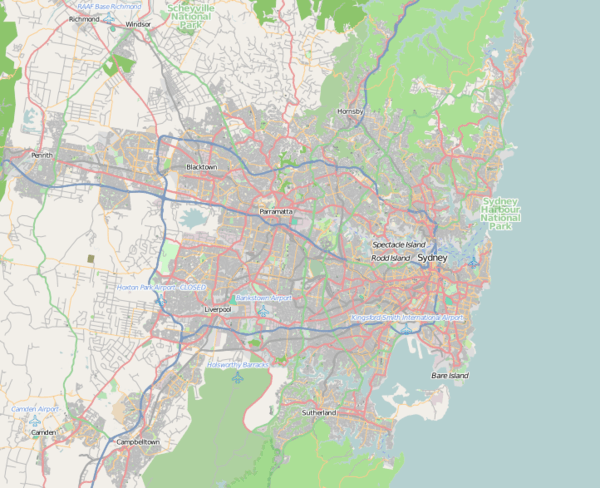Downing Centre
| Downing Centre | |
|---|---|
|
Downing Centre, Sydney, as view from Hyde Park. | |
 Location in Greater Sydney | |
| Former names | Mark Foy's Piazza Store |
| Etymology | Reg Downing, Attorney General and Minister for Justice[1] |
| General information | |
| Status | Complete |
| Type |
|
| Architectural style | Interwar Stripped Classical |
| Location | 302 Castlereagh Street, Sydney, New South Wales |
| Country | Australia |
| Coordinates | 33°52′39″S 151°12′33″E / 33.8774°S 151.2091°ECoordinates: 33°52′39″S 151°12′33″E / 33.8774°S 151.2091°E |
| Construction started | 1901 |
| Opened | 1908 |
| Renovated | 1924, 1985 |
| Client | Mark Foy's |
| Owner | Government of New South Wales |
| Landlord | Department of Justice |
| Technical details | |
| Material | Brick, iron |
| Floor count | 8 |
| Design and construction | |
| Architect | Arthur Anderson |
| Architecture firm | McCredie & Anderson |
| Main contractor | Douzans Bros |
| Renovating team | |
| Architect |
|
| Official name | Sydney Downing Centre |
| Type | Built |
| Designated | 2 April 1999 |
| Reference no. | 000393 |
| References | |
| [2] | |
The Downing Centre is a major courthouse complex in Sydney, New South Wales, Australia. It features state government courts, including the Local Court, the District Court, and a law library known as the Downing Centre Library. The Downing Centre forms part of the Department of Justice and houses court services and sheriffs offices.
The Downing Centre is located in the Sydney central business district, on Liverpool Street, between Elizabeth Street and Castlereagh Street. It sits opposite the south-west corner of Hyde Park and Museum railway station. A subway links the Downing Centre directly to Museum Station from an entrance on Castlereagh Street.
Originally called the Mark Foy's Piazza Store, the building was renamed as the Downing Centre in 1991 in honour of Reg Downing, a former NSW Attorney General and Minister for Justice.[1]
History
Initially a two-storey building designed by Arthur Anderson of the architectural firm McCredie & Anderson,[2] the Downing Centre was built in 1908 in the Australian Interwar Stripped Classical architectural style as a retail emporium for Mark Foy's.[3] In 1924, Spain Cosh & Epslin Architects, in consultation with Ross & Rowe Architects, were paid to design eight alterations and additions. The building was originally intended to cover the whole block but was not completed. It is now an eight-storey building with portions of the original building remaining intact. The façade employs the classical orders using white bricks with yellow faience work to the sills and cornices. Two corner towers with yellow pinnacles surmount the building. Art Nouveau influences are evident in the external detailing. Mark Foy's closed in 1980 and was taken over by Grace Bros. who traded there until 1983.[2]
The building was converted for use as courts in 1985. On 20 October 1980 the building was listed on the (now defunct) Register of the National Estate;[4][5] and on 2 April 1999 was listed on the New South Wales State Heritage Register with the following statement of significance:[2]
The Downing Centre is accommodated within a major interwar retailing building which was owned and operated as Mark Foys for most of the 20th century until the 1980s. Prominently located at the intersection of Castlereagh and Liverpool Streets, it is a landmark building of the interwar period in Sydney.
— Statement of significance, New South Wales State Heritage Register.
Gallery
 Downing Centre, detail
Downing Centre, detail Downing Centre, detail
Downing Centre, detail Museum station entrance at the Downing Centre, Castlereagh Street
Museum station entrance at the Downing Centre, Castlereagh Street- Museum station subway from the Downing Centre entrance
See also
References
- 1 2 "Death Of Robert Reginald Downing, A Former Minister Of The Crown". Hansard, New South Wales Legislative Council. Parliament of New South Wales. 13 September 1994. Archived from the original on 6 September 2014. Retrieved 6 December 2012.
- 1 2 3 4 "Sydney Downing Centre". NSW State Heritage Register. Office of Environment & Heritage, Government of New South Wales. 31 January 2002. Retrieved 13 January 2017.
- ↑ "The Downing Centre Awning Project". Wunderlite Reproduction Panels.
- ↑ "Mark Foys Building (former), 143-147 Liverpool St, Sydney, NSW, Australia (Place ID 1821)". Australian Heritage Database. Department of the Environment. Retrieved 1 November 2017.
- ↑ Australian Heritage Commission (1981), The Heritage of Australia: the illustrated register of the National Estate, 2, South Melbourne: The Macmillan Company of Australia in association with the Australian Heritage Commission, p. 104, ISBN 978-0-333-33750-9
Attribution
![]()
External links
| Wikimedia Commons has media related to Downing Centre. |